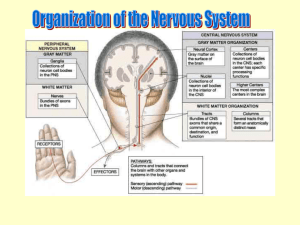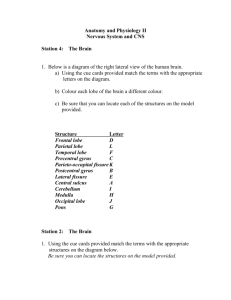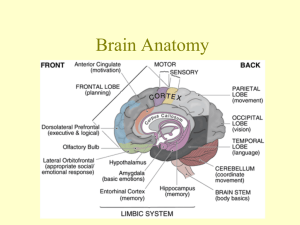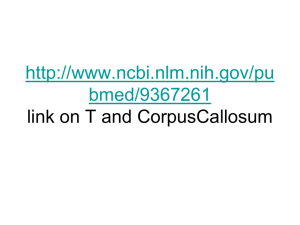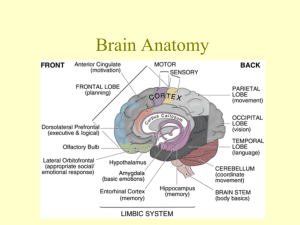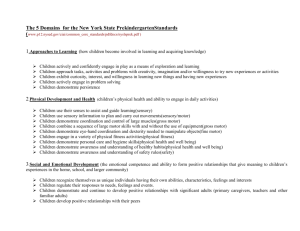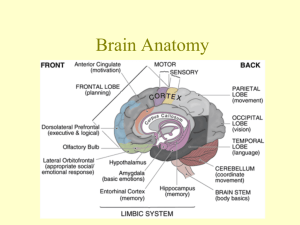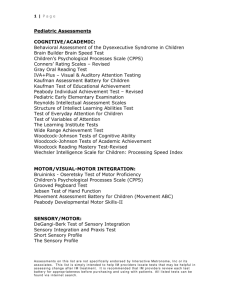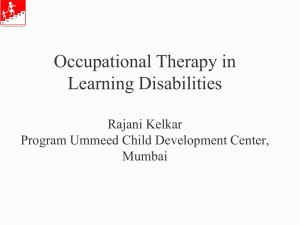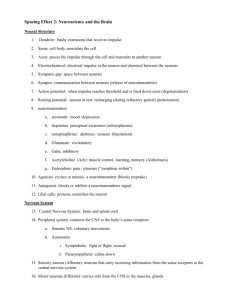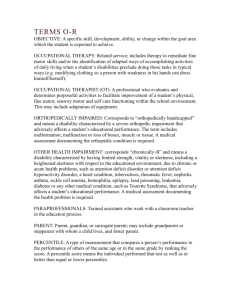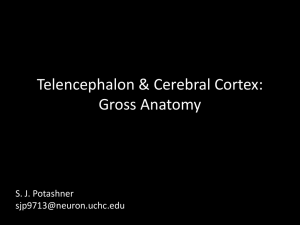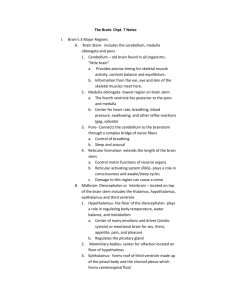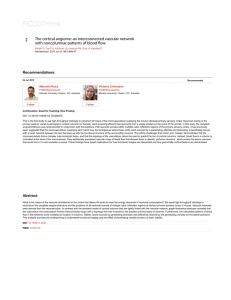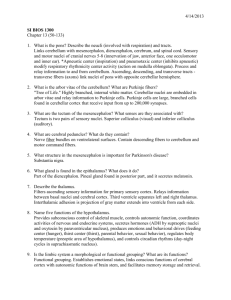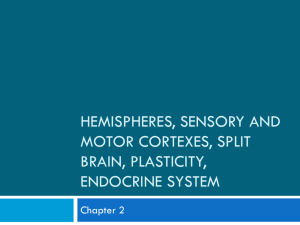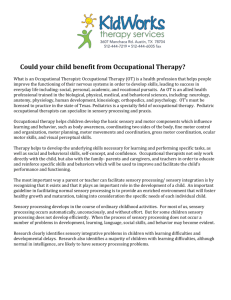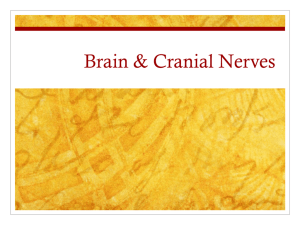CS 160 * Comparative Cognition * Spring 02
advertisement
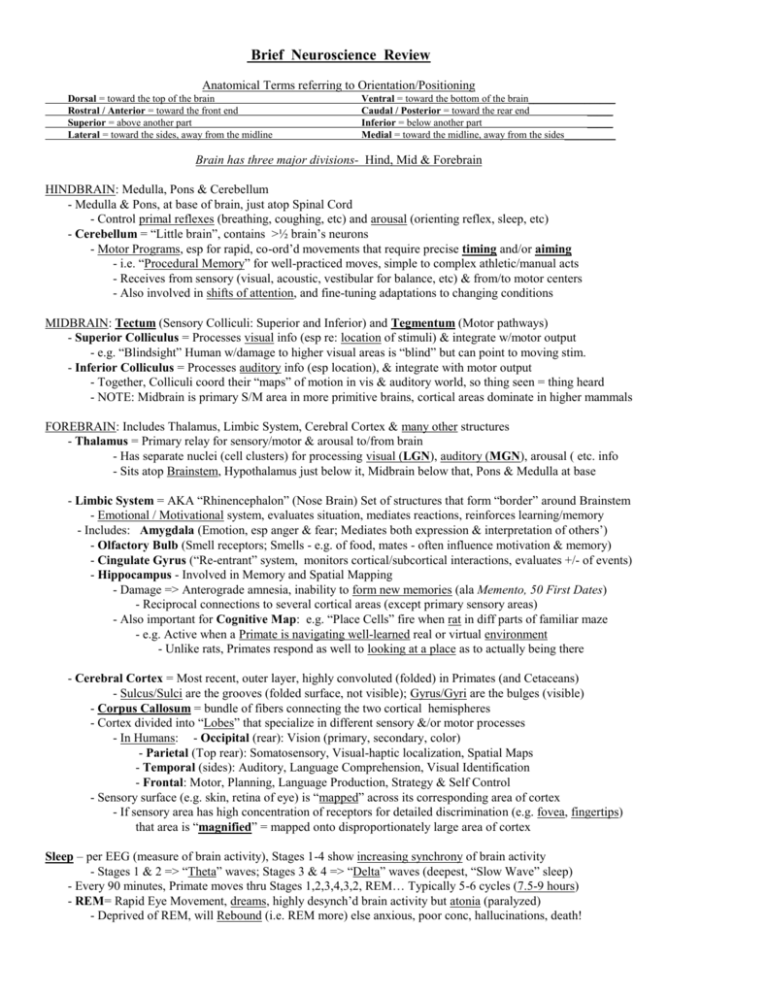
Brief Neuroscience Review Anatomical Terms referring to Orientation/Positioning Dorsal = toward the top of the brain Rostral / Anterior = toward the front end Superior = above another part Lateral = toward the sides, away from the midline Ventral = toward the bottom of the brain_________________ Caudal / Posterior = toward the rear end _____ Inferior = below another part _____ Medial = toward the midline, away from the sides__________ Brain has three major divisions- Hind, Mid & Forebrain HINDBRAIN: Medulla, Pons & Cerebellum - Medulla & Pons, at base of brain, just atop Spinal Cord - Control primal reflexes (breathing, coughing, etc) and arousal (orienting reflex, sleep, etc) - Cerebellum = “Little brain”, contains >½ brain’s neurons - Motor Programs, esp for rapid, co-ord’d movements that require precise timing and/or aiming - i.e. “Procedural Memory” for well-practiced moves, simple to complex athletic/manual acts - Receives from sensory (visual, acoustic, vestibular for balance, etc) & from/to motor centers - Also involved in shifts of attention, and fine-tuning adaptations to changing conditions MIDBRAIN: Tectum (Sensory Colliculi: Superior and Inferior) and Tegmentum (Motor pathways) - Superior Colliculus = Processes visual info (esp re: location of stimuli) & integrate w/motor output - e.g. “Blindsight” Human w/damage to higher visual areas is “blind” but can point to moving stim. - Inferior Colliculus = Processes auditory info (esp location), & integrate with motor output - Together, Colliculi coord their “maps” of motion in vis & auditory world, so thing seen = thing heard - NOTE: Midbrain is primary S/M area in more primitive brains, cortical areas dominate in higher mammals FOREBRAIN: Includes Thalamus, Limbic System, Cerebral Cortex & many other structures - Thalamus = Primary relay for sensory/motor & arousal to/from brain - Has separate nuclei (cell clusters) for processing visual (LGN), auditory (MGN), arousal ( etc. info - Sits atop Brainstem, Hypothalamus just below it, Midbrain below that, Pons & Medulla at base - Limbic System = AKA “Rhinencephalon” (Nose Brain) Set of structures that form “border” around Brainstem - Emotional / Motivational system, evaluates situation, mediates reactions, reinforces learning/memory - Includes: Amygdala (Emotion, esp anger & fear; Mediates both expression & interpretation of others’) - Olfactory Bulb (Smell receptors; Smells - e.g. of food, mates - often influence motivation & memory) - Cingulate Gyrus (“Re-entrant” system, monitors cortical/subcortical interactions, evaluates +/- of events) - Hippocampus - Involved in Memory and Spatial Mapping - Damage => Anterograde amnesia, inability to form new memories (ala Memento, 50 First Dates) - Reciprocal connections to several cortical areas (except primary sensory areas) - Also important for Cognitive Map: e.g. “Place Cells” fire when rat in diff parts of familiar maze - e.g. Active when a Primate is navigating well-learned real or virtual environment - Unlike rats, Primates respond as well to looking at a place as to actually being there - Cerebral Cortex = Most recent, outer layer, highly convoluted (folded) in Primates (and Cetaceans) - Sulcus/Sulci are the grooves (folded surface, not visible); Gyrus/Gyri are the bulges (visible) - Corpus Callosum = bundle of fibers connecting the two cortical hemispheres - Cortex divided into “Lobes” that specialize in different sensory &/or motor processes - In Humans: - Occipital (rear): Vision (primary, secondary, color) - Parietal (Top rear): Somatosensory, Visual-haptic localization, Spatial Maps - Temporal (sides): Auditory, Language Comprehension, Visual Identification - Frontal: Motor, Planning, Language Production, Strategy & Self Control - Sensory surface (e.g. skin, retina of eye) is “mapped” across its corresponding area of cortex - If sensory area has high concentration of receptors for detailed discrimination (e.g. fovea, fingertips) that area is “magnified” = mapped onto disproportionately large area of cortex Sleep – per EEG (measure of brain activity), Stages 1-4 show increasing synchrony of brain activity - Stages 1 & 2 => “Theta” waves; Stages 3 & 4 => “Delta” waves (deepest, “Slow Wave” sleep) - Every 90 minutes, Primate moves thru Stages 1,2,3,4,3,2, REM… Typically 5-6 cycles (7.5-9 hours) - REM= Rapid Eye Movement, dreams, highly desynch’d brain activity but atonia (paralyzed) - Deprived of REM, will Rebound (i.e. REM more) else anxious, poor conc, hallucinations, death!

